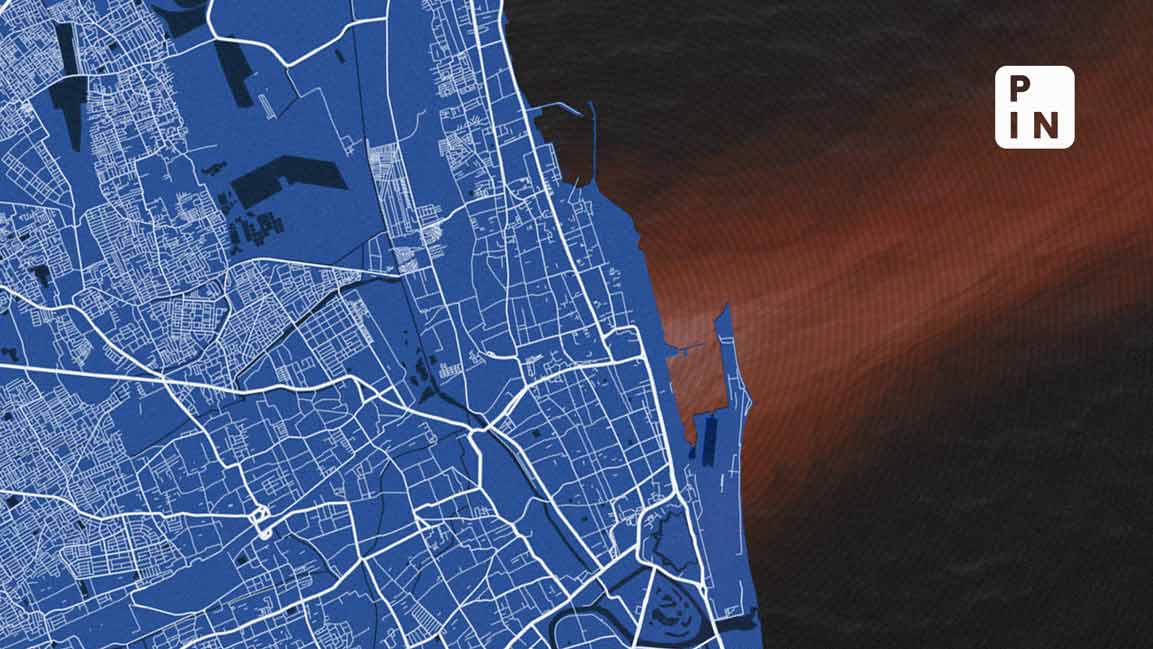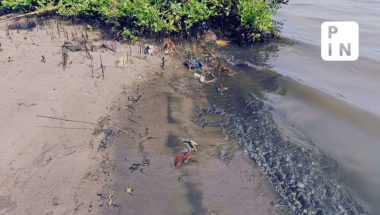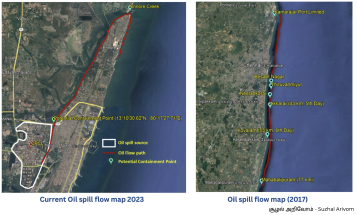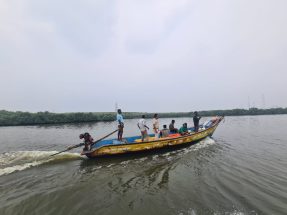- | 6:00 pm
Chennai, Asia’s Detroit, advances rapidly, but safety takes a backseat
A string of industrial accidents in the past month, especially an oil spill, underscores the need for stringent safety measures and environmental safeguards in Asia’s burgeoning automotive hub

In recent weeks, Chennai—the capital of Tamil Nadu that is renowned as the Detroit of Asia for its thriving automotive industry—has seen a string of industrial accidents, sparking concerns over safety and environmental safeguards.
The ordeal began exactly a month ago, on 4 December, in the wake of Cyclone Michaung as intense rains battered India’s southeastern coast, leading fishermen in the Kosasthalaiyar river near Ennore to uncover a disturbing sight—a thick black oil spill.
The spill, which coated boats in oil and led to health problems including eye irritation and dizziness among locals, became challenging to contain as the raging cyclone had knocked out power.
Citizens’ woes were further compounded the same month by a toxic ammonia leak at Coromandel International’s Ennore plant, which was immediately followed by a deadly fire at state-run Indian Oil Corp. Ltd’s Chennai facility that claimed one life.
This series of accidents underscores a growing urgency to put in place robust protocols and stronger environmental safeguards in a rapidly developing industrial zone.

Oil leaked into the Kosasthalaiyar river via the Buckingham Canal and reached the Ennore estuary, a crucial fishing ground, and spread almost 20 square kilometers in the sea. Picture courtesy: Smitha T.K.
The Ennore oil spill
An investigation led by the government into the Ennore oil spill identified the source as a refinery operated by Chennai Petroleum Corp. Ltd (CPCL), a subsidiary of Indian Oil Corp.
The impact of the spill was far-reaching, extending into the Ennore creek wetland, an ecologically sensitive area teeming with mangroves, birds, fish, and turtles.
The spill’s penetration into the riverbed led to significant mangrove contamination. The environmental damage was severe, with oil toxins killing fish and at least 50 pelicans.
After the storm subsided, the Tamil Nadu Pollution Control Board conducted an inspection on 7 December and found ‘traces of oil’ along the banks of the Buckingham Canal, adjacent to Ennore.
Explaining the cause of the oil spill, CPCL said the canal’s water level rose one meter above the usual storm-water level following the heavy rains, which caused a reverse flow. “Contrary to media reports, there was no pipeline leak in the refinery,” it said in a statement.
Taking suo moto cognizance, the National Green Tribunal (NGT) questioned the pollution control board’s seemingly subdued response and issued a notice to the state government.

Due to the spill, several fish and at least 50 pelicans were found dead and several birds were spotted caked with oil. Picture courtesy: Smitha T.K.
Lack of decisive action
The NGT’s move was met with skepticism by green activists.
“The NGT taking suo moto cognizance actually poses a problem. It appears to be a diplomatic brush-up, rather than a decisive action. So far, CPCL hasn’t faced any legal charges. This seems to be more about optics than substantive action,” Nityanand Jayaraman, a local environmentalist, said.
Terming the oil spill an “irresponsible industrial accident,” environment activists and fisher folk called on authorities to act.
“You need to really understand the area you are in and its issues. Companies must prioritize safety, and involve locals who know the area well. We also need to keep up with new technology,” Deepak Venkatachalam of Suzhal Arivom, a Chennai-based environmental group, said.
“In other countries, major oil spills result in heavy fines to prevent repeat offenses. Here, the regulatory authority only issues notices, advising violators on corrective measures. We should be holding violators accountable, imposing the legally mandated heavy fines, and ensuring their arrest for inaction,” Venkatachalam added.
The state government, meanwhile, is proceeding with caution.
“We’ve completed only the emergency and recovery work. This isn’t a quick-fix job. A systematic and scientific approach is essential for this cleanup,” Supriya Sahu, an additional chief secretary of environment in the state, said.
“To tackle this effectively, we’ve brought in experts from the Indian Institute of Technology-Madras, the National Institute of Oceanography in Goa, the National Centre for Coastal Research, the National Centre for Sustainable Coastal Management, and the M. S. Swaminathan Research Foundation. Their role is to assess the full extent of the damage, predict the dispersion of the oil deposits, and then help us devise a comprehensive strategy,” Sahu said.
To clean up the polluted waters, CPCL said it had brought in boomers to contain and control the spread of oil, and deployed skimmers and absorbent pads to soak it up.
“The creek area is almost clear of oil, and cleanup activity in Ennore creek by professional agencies is nearing completion. 90% of the shore is cleaned and (the) balance (is) expected to be completed by tomorrow.” CPCL posted on X (formerly Twitter) on 20 December, a fortnight after the oil spill.
CPCL did not immediately respond to a query on the status of the cleanup. The story will be updated once CPCL responds.
Meanwhile, Sahu said Tamil Nadu state authorities had reached out to officials in Odisha and Mumbai to find out if they had faced a similar crisis in their mangroves, but this was a first.
“There’s a standard operating procedure for oil spills in the ocean, but there’s no established SOP for spills in estuaries, so our response had to be improvised,” she said.
The BP oil spill of April 2010, also known as the Deepwater Horizon spill, was one of the largest marine oil spills in history, releasing about 4.9 million barrels (210 million gallons) of oil into the Gulf of Mexico over 87 days. The spill covered a vast area, significantly impacting marine and coastal ecosystems along the Gulf’s shores.
The cleanup continued for years, with the total cost, including legal settlements, amounting to about $65 billion for BP.

Oil spill redux in Ennore
Meanwhile, this is not the first time that Ennore, a hub of thermal power stations, fertilizer factories, industrial ports, and an eco-sensitive zone, is witnessing an oil spill.
In 2017, the collision of two tankers near the Kamarajar port led to a massive spill, impacting the local marine ecosystem and livelihoods. Considerable efforts were required to remove the heavy bunker fuel that polluted the shores.
The fishermen that Press Insider spoke to said the fallout of that oil spill had lingered over fishing activities for nearly four years.
“History is repeating itself, and still no industries have protocols. We are always made to do the dirty work,” said Ramesh, a fisherman.
During the cleanup operations then, social media trolls had cynically dubbed the whole procedure “bucket technology”.
“Earlier, fishermen used buckets. But this time, it’s mugs. It seems our preparedness plans aren’t taken seriously,” Shravan Krishnan, who works with the Chennai Wildlife Department to rescue birds affected by the spill, said.
Kumaresan, a fisherman from Ennore, said: “Initially, we were given just a mug, a tub, and a funnel. It wasn’t until the media highlighted our situation that they started to follow some protocol. However, even after five days, not everyone received proper safety equipment. We’re doing this to protect our ocean and livelihoods, but it’s putting our lives at risk.”
“Failure to follow protocols amounts to criminal negligence. Often in industrial accidents, the higher-ups or managers are not prosecuted. Instead, it’s usually those speaking up for the victims who face criticism and harassment,” E.A.S. Sarma, a former secretary in the Union ministries of power and finance said in a letter to Tamil Nadu chief minister M.K. Stalin.

With no electricity, cleanup during the first three days of the spill was a nightmare, said locals. Picture courtesy: Smitha T.K.
Oil spill contingency plan
Some scientists and green activists question the efficacy of the National Oil Spill Disaster Contingency Plan, a framework that was set up to manage and respond to oil spills.
In 2015, the Coast Guard had overhauled the contingency plan in a bid to meet global standards, but environmentalists said that in practice, the ‘polluter pays’ principle is often overlooked.
“Failure in law enforcement by the pollution control board has led to serious disasters. If regulatory agencies effectively did their duties, there will be proper checks and balances, discouraging repeat offenses,” environmentalist Jayaraman said.
In its fiscal 2021-22 budget, the state government had unveiled the Tamil Nadu Wetlands Mission that focused on ecological restoration.
Yuvan Aves, a naturalist working closely with the government, said, “Had that mission been in place today, strict regulations could have preserved the creek. In Ennore, industries often question the necessity of compliance due to widespread degradation. Our goal is to change this narrative, showing that even the most abused areas have significant potential for life.”
Illegal dumping and ash spillage from the North Chennai Thermal Power station are choking the life out of Ennore creek
Government official Sahu said the state is now devising a plan to rehabilitate the industrial belt in Ennore, which involves implementing regulations to ensure legal compliance, creating additional green spaces, and setting up a foolproof monitoring system.
The fisher folk, meanwhile, are facing the brunt.
“While people in the city were protesting for access to electricity and highlighting poor management of storm water drains, we are lamenting the loss of livelihoods, the sea and our health,” said Kumaresan.
Fishermen can only return to sea once their boats are repaired, the marine ecosystem is restored, and the water is cleared of oil. With no clear timeline for all these, there’s a growing sense of anxiety and fear.
More than 2,000 fishermen from the nine fishing villages of Ennore have not ventured into the Kosasthalaiyar river or the sea since the beginning of December, when a red alert was issued ahead of Cyclone Michaung.
“A boat costs about ₹1 lakh ($1,200). The government announced that each family will receive ₹12,500 ($150), with an additional ₹10,000 ($120) for the repair of damaged boats. How is that enough?” asked Kumaresan.













